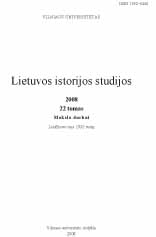Arijų protėvynės beieškant (Antroji Lietuvos archeologinė ekspedicija Afganistane)
In pursuit of aryan homeland (2nd Lithuanian archaeological expedition in Afganistan)
Author(s): Aleksiejus Luchtanas, Ramunė ButrimaitėSubject(s): Archaeology
Published by: Vilniaus Universiteto Leidykla
Summary/Abstract: The second Lithuanian archaeological expedition in the province of Ghor is a constituent part of the long-term programme “Archaeological – Heritage Mission in Ghor Province, Afghanistan, 2007–2010”. The programme is financed by the Ministry of Foreign Affairs, Republic of Lithuania. The programme is carried out by the Archaeological Projects Centre ANTIQUA. The partners of the project are the Ministry of National Defence of the Republic of Lithuania and Vilnius University. The purpose of the lasting project was contribution to the work of preservation of objects of cultural value in the Islamic Republic of Afghanistan by paying particular attention to search of archaeological sites and their documentation aimed at entering them into the national register of cultural monuments. During the expedition the archaeological sites found in the course of Feasibility Study 2007 were visited and in parallel new ones were sought with the purpose of documenting the objects of archaeological value existing in Ghor province. Register certificates were started for 11 archaeological sites discovered last year (Kushke Bahar (Qala Mana), Qala Akbar Bek Zahak, Qala Malek Antar, Puze-i-Leche tapa, Lok Galandar Tower, Lok Galandar tapa (Shekhe), Pumbakar and Ahangaran tapa No 1–5) as well as for 9 ones found anew (Qala Alayar, Sare Ahangaran 1, Sare Ahangaran 2, Dowlat Yar tapa, Geshwoinde tapa, Qalesang tapa, Zahak tomb (Hesar) Wajguna Sange-Bar monastery and tapa). These are ancient settlements or tapa chronologically dating back to the Anaeolithic period and the Bronze Age and castles of the 1st millennium AD. During the expedition new groups of cultural value were surveyed, too. These were the site of worship, Qabre Zahak, rock carvings at Qala Malek Antar of the 2nd millennium BC and the Buddhist monastery of the first half of the 1st millennium AD. No doubt,Wajguna Sange-Bar Buddhist monastery is one of the most interesting archaeological sites in Chaghcharan environs having many analogues with the cultural landscape of Bamiyan valley entered into the list UNESCO heritage. The discovered monastery is important from the historical and cultural aspect, its localization in the central Afghanistan shows the spread of Buddhism into the west in the times of the Kushan empire. It is possible that this is the most distant site of Buddhism in the west.
Journal: Lietuvos istorijos studijos
- Issue Year: 2008
- Issue No: 22
- Page Range: 163-177
- Page Count: 15
- Language: Lithuanian

